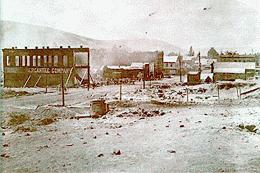On July 18, 1900, an accidental fire starts in a saloon in downtown Pomeroy and destroys nearly half the business district. Four people are overcome by heat while fighting the fire, and several others sustain minor injuries, but no fatalities are reported. Damages are reported to be at least $135,800. Pomeroy is located in Garfield County in southeastern Washington at the center of an agricultural region growing mainly wheat.
Booming Before Burning
Pomeroy, with agriculture as its economic base, was booming in the summer of 1900. The rapid population increase and financial prosperity that the town had enjoyed in the late 1890s was continuing in 1900, with construction of new homes and businesses moving ahead at a pace never before seen in the 22-year history of the town.
On Wednesday afternoon, July 18, 1900, fire suddenly broke out at E. J. Rice's Saloon on Main Street. Rice and an associate, Mr. Kirby, were filling a gas light generator tank in the saloon. The men had put some gasoline into an open container, and some of it spilled onto the floor. Evidently forgetting the hazard, Kirby struck a match. In a flash, the gasoline fumes in the room ignited, with the gasoline in the container providing additional fuel. A sheet of flame exploded through the building, with a thick cloud of smoke and fire shooting out of the north end of the building halfway into the street. By the time firefighters arrived at the scene minutes later with two hose carts and a hook and ladder truck, the entire front end of the saloon was ablaze.
Although Chief Thompson and his firefighters worked "manfully," the dry wooden buildings on either side of the saloon were "rapidly licked up like a large quantity of shavings" (Shaver). But it was the buildings east of the saloon that bore the brunt of the fire. Fanned by stiff westerly winds, flames soon devoured the Garfield County courthouse and then consumed the remaining buildings east of the courthouse on the north side of Main except for the blacksmith shop of Krause & Hoffman and T. E. Benbow's wagon shop.
The fire also destroyed all of the businesses on the south side of Main Street as far east as 5th Street. But on this side of the street, a few merchants had time to save their merchandise before fire destroyed their buildings. Still, damages were reported to be at least $135,800 (in 1900 dollars), with less than half of the damage covered by insurance. At least 39 businesses were damaged or destroyed. Four people were overcome by the fire's heat while fighting the fire or while saving merchandise, and a few others sustained minor burns, but there were no fatalities.
Recovering to Boom Again
Pomeroy made a remarkable recovery from the conflagration. Before the fire, the Pomeroy city council had passed a resolution requiring all new construction downtown to be of fire-proof material, which in those days primarily meant brick. A brief attempt after the fire to repeal the resolution and allow reconstruction of wooden buildings in the downtown area failed, resulting in the wooden buildings destroyed by the fire being replaced by brick ones. By October 1900, 11 new buildings were under construction. To help expedite rebuilding, for 60 days the Oregon Railroad and Navigation Company granted a one-third reduction in freight rates for shipping building material.
By February 1902 much of the Pomeroy's business district had been rebuilt, and a new courthouse had just opened. By 1904 it was apparent that Pomeroy had not only survived the fire but had benefited from it. The resulting building boom continued to add to Pomeroy's swelling population and financial prosperity as the twentieth century got underway.

